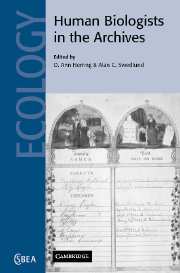 Human Biologists in the Archives
Human Biologists in the Archives Book contents
- Frontmatter
- Contents
- Contributors
- Foreword by Sydel Silverman and Michael A. Little
- Acknowledgements
- 1 Human biologists in the archives: demography, health, nutrition and genetics in historical populations
- 2 The use of archives in the study of microevolution: changing demography and epidemiology in Escazú, Costa Rica
- 3 Anthropometric data and population history
- 4 For everything there is a season: Chumash Indian births, marriages, and deaths at the Alta California missions
- 5 Children of the poor: infant mortality in the Erie County Almshouse during the mid nineteenth century
- 6 Worked to the bone: the biomechanical consequences of ‘labor therapy’ at a nineteenth century asylum
- 7 Monitored growth: anthropometrics and health history records at a private New England middle school, 1935–1960
- 8 Scarlet fever epidemics of the nineteenth century: a case of evolved pathogenic virulence?
- 9 The ecology of a health crisis: Gibraltar and the 1865 cholera epidemic
- 10 War and population composition in Åland, Finland
- 11 Infectious diseases in the historical archives: a modeling approach
- 12 Where were the women?
- 13 Malnutrition among northern peoples of Canada in the 1940s: an ecological and economic disaster
- 14 Archival research in physical anthropology
- Index
- References
4 - For everything there is a season: Chumash Indian births, marriages, and deaths at the Alta California missions
Published online by Cambridge University Press: 12 August 2009
- Frontmatter
- Contents
- Contributors
- Foreword by Sydel Silverman and Michael A. Little
- Acknowledgements
- 1 Human biologists in the archives: demography, health, nutrition and genetics in historical populations
- 2 The use of archives in the study of microevolution: changing demography and epidemiology in Escazú, Costa Rica
- 3 Anthropometric data and population history
- 4 For everything there is a season: Chumash Indian births, marriages, and deaths at the Alta California missions
- 5 Children of the poor: infant mortality in the Erie County Almshouse during the mid nineteenth century
- 6 Worked to the bone: the biomechanical consequences of ‘labor therapy’ at a nineteenth century asylum
- 7 Monitored growth: anthropometrics and health history records at a private New England middle school, 1935–1960
- 8 Scarlet fever epidemics of the nineteenth century: a case of evolved pathogenic virulence?
- 9 The ecology of a health crisis: Gibraltar and the 1865 cholera epidemic
- 10 War and population composition in Åland, Finland
- 11 Infectious diseases in the historical archives: a modeling approach
- 12 Where were the women?
- 13 Malnutrition among northern peoples of Canada in the 1940s: an ecological and economic disaster
- 14 Archival research in physical anthropology
- Index
- References
Summary
Introduction
The demographic history of the Chumash Indians who lived in the Santa Barbara Channel area of southern California is better documented than that of almost any other North American Indian population. An exceptionally complete archeological record makes it possible to chart population growth and changing settlement patterns during the long prehistory of this area. More importantly from the perspective of this book, an extraordinarily complete set of ecclesiastical records survives that allows the demographic consequences that European contact had for the Chumash to be studied in great detail.
A key element of Spanish colonial policy was removal of the Chumash from their native villages to mission communities where priests could give them religious instruction and vocational training. In addition to providing the local Indians with the perceived benefits of Christianity, this colonial strategy strengthened Spain's grasp on the northern borderlands of its New World holdings. These religious and political goals were pursued using Indian laborers to build a series of missions and garrisoned forts at strategic locations along the California coast (Fig. 4.1). Spain viewed these bastions of its colonial presence as essential for preventing other nations, especially Russia, from seizing control of Alta California. To measure the success of their proselytizing efforts, the priests at each mission were required to keep careful records of births, deaths, baptisms, marriages, and other important events in the lives of the neophytes (baptized Indian people) under their control. This was a task most of them performed both conscientiously and with considerable zeal.
- Type
- Chapter
- Information
- Human Biologists in the ArchivesDemography, Health, Nutrition and Genetics in Historical Populations, pp. 53 - 77Publisher: Cambridge University PressPrint publication year: 2002


